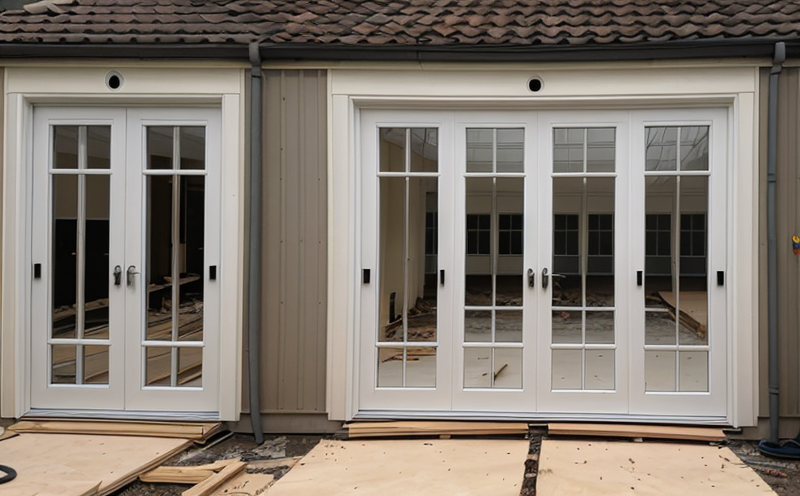Fire Resistance Testing of Demountable Partitions
Demountable partitions are a vital component in modern fire safety design. They provide flexibility and efficiency by allowing for the easy reconfiguration of spaces within buildings, but their effectiveness in resisting fire is crucial to ensure they meet regulatory requirements and offer adequate protection.
The process of testing demountable partitions involves subjecting them to controlled laboratory conditions that simulate real-world fire scenarios. This ensures that these partitions can withstand exposure to heat, flames, and smoke for a specified period without collapsing or compromising the integrity of other parts of the building. The testing protocol is designed to assess not only the structural stability but also the ability of the partition to prevent the spread of fire and toxic gases.
For effective fire resistance testing, it is essential that the specimen is prepared according to standard procedures. This includes ensuring the correct dimensions, securing the specimen within the furnace setup, and applying appropriate supports or fixings as specified by the test method being used. The choice of test method can vary based on local regulations; for instance, methods such as EN 1363-2 may be relevant for fire resistance testing in Europe.
The test apparatus typically consists of a furnace capable of generating heat and flames at controlled levels. Specimens are exposed to these conditions for the duration specified by the chosen standard. Throughout the process, various measurements are taken using thermocouples or other sensing devices attached to the specimen. These measurements help in evaluating how well the partition maintains its structural integrity and prevents the spread of fire.
The criteria for passing a fire resistance test are stringent and vary depending on local regulations. Generally, partitions must maintain their structural stability for at least 30 minutes under specified conditions, although longer durations may be required based on specific building codes or client requirements. The ability to resist the passage of flames and gases is also evaluated critically.
Passing this test ensures that demountable partitions meet stringent fire safety standards, thereby providing peace of mind for architects, designers, builders, and clients alike. This testing process plays a crucial role in ensuring compliance with international standards such as EN 1363-2 or ASTM E119. By adhering to these rigorous tests, manufacturers can demonstrate the reliability and effectiveness of their products.
It is important to note that fire resistance testing is not just about meeting regulatory requirements; it also contributes significantly to enhancing public safety by ensuring that buildings are equipped with effective fire protection measures. The results of such tests provide valuable data for ongoing improvements in fire safety technology and design practices.
Benefits
The benefits of undergoing fire resistance testing extend beyond mere compliance with regulatory requirements. By ensuring that demountable partitions meet stringent fire safety standards, building owners and designers can enhance the overall safety and security of their structures.
Firstly, successful completion of these tests provides a strong foundation for trustworthiness among clients and stakeholders. This can lead to increased business opportunities and long-term partnerships within the industry. Secondly, it ensures that buildings comply with relevant international standards such as EN 1363-2 or ASTM E119, which are widely recognized across different regions.
Moreover, fire resistance testing helps in identifying potential weaknesses early on during product development stages. This allows manufacturers to make necessary improvements before products reach the market, leading to higher quality and more reliable products over time.
In addition, the results of these tests can be used for marketing purposes, highlighting a company’s commitment to safety and innovation. This not only attracts potential customers but also fosters brand loyalty amongst existing clients.
International Acceptance and Recognition
The importance of fire resistance testing cannot be overstated, especially when considering the global nature of construction projects. Many countries have adopted international standards such as EN 1363-2 or ASTM E119 for evaluating fire performance due to their rigorous methodologies and consistent results.
These internationally recognized standards provide a common language that facilitates easier communication between different stakeholders involved in the design, manufacturing, installation, and maintenance of buildings worldwide. They ensure consistency across borders by providing clear guidelines on how to conduct tests and interpret results accurately.
The acceptance of these standards by various national authorities around the globe has led to widespread use among professionals responsible for specifying materials and components used in building construction. This global recognition enhances interoperability between projects located in different parts of the world, promoting collaboration and knowledge sharing amongst practitioners from diverse backgrounds.
Use Cases and Application Examples
| Application Scenario | Description |
|---|---|
| Office Buildings | In office buildings, demountable partitions are often used to divide large open spaces into smaller functional areas. Ensuring these partitions meet fire resistance requirements is crucial for maintaining safety during emergencies. |
| Data Centers | Fire resistance testing ensures that data centers remain secure against potential fires, protecting valuable equipment and sensitive information stored within them. |
| Hospitals | In hospitals, where patient safety is paramount, fire-resistant partitions help safeguard patients and staff by preventing the rapid spread of flames or smoke. |
| Commercial Spaces | For commercial spaces such as retail stores or restaurants, fire resistance testing ensures that any partitioning done helps maintain safety levels during emergencies. |
| Schools and Universities | In educational facilities, fire-resistant partitions are essential for creating safe environments where students can learn without fear of fire hazards. |
| Residential Buildings | Even in residential buildings, partitions play a role in fire safety by providing additional barriers to contain fires within specific areas, thus protecting the entire structure from damage. |





